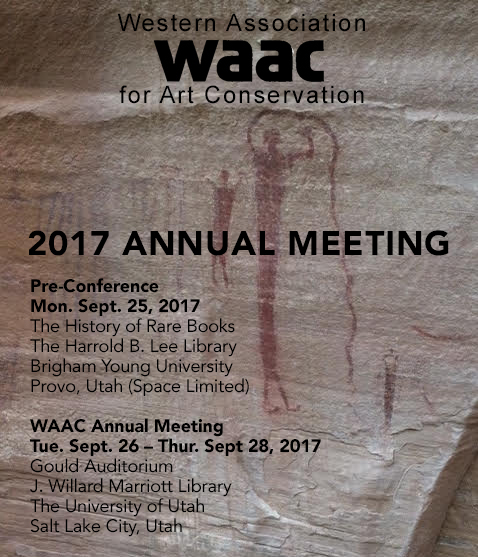Characterization of the Aniline Dyes in the Colored Papers of José Posada’s Prints Using Time-of-Flight Secondary Ion Mass Spectrometry to aid in Developing a Treatment Protocol for the Removal of Pressure-sensitive Tapes
Abstract
Jose Guadalupe Posada (1852-1913) was a prolific and influential Mexican printmaker; he produced thousands of images printed on a variety of poor-quality papers, often colored with vibrant but fugitive aniline dyes. The Amon Carter Museum of American Art has a large collection of approximately 400 prints attributed to Posada, many of which retain their bright color. A number of these are unstable due to oxidized pressure-sensitive tape residue, penetrating and weakening the short-fibered paper. In addition, aniline dyes are sensitive to solvents, complicating treatment.Because aniline dyes have varying sensitivities to different solvents it is necessary to characterize them before an appropriate treatment protocol can be developed. A previous study of Posada's prints identified several aniline dyes using Fourier Transform (FT)-Raman spectroscopy. Of these, the yellow dyes could not be fully characterized. In this study, time-of-flight secondary ion mass spectrometry (TOF SIMS) was used to discern the dyes present in the colored papers with particular focus on the yellow dyes.
TOF SIMS is a valuable analytical technique for the identification of organic and inorganic components. Its high sensitivity and small sample size requirements make it potentially useful for the analysis of dyes and works on paper. For this study, a selection of Posada's prints in various colors from the Amon Carter's collection were examined using TOF SIMS, producing significant data for all the dyes analyzed.
As part of developing a treatment protocol for the Posada prints, an experiment was set up using artificially aged paper and tapes to simulate the removal of oxidized tape from fragile dyed papers. A variety of methods were employed. Samples were created by applying Scotch MagicTM tape (acetate backing; acrylic adhesive), 3M 2214 paper tape (crepe paper backing; rubber adhesive), gummed brown paper tape (kraft paper backing; starch adhesive), and Slime rubber cement to several c.1900s dyed and undyed broadsides, mimicking the Posada prints. The samples were then ‘treated' with solvent and suction, rigid Gellan gum with solvent, and solvent through Gore-tex sandwich. The samples were imaged using visible light and Ultra-Violet (UV) light before and after treatment, along with spectrophotometer readings to monitor and record any changes in the samples.
Because aniline dyes are prevalent in many turn of the century objects, as are oxidized tapes, developing an effective treatment protocol has tremendous potential benefit.
Click on Video link on the right to view presentation.
Published
2017-11-28
How to Cite
KELLY, Stacey M. et al.
Characterization of the Aniline Dyes in the Colored Papers of José Posada’s Prints Using Time-of-Flight Secondary Ion Mass Spectrometry to aid in Developing a Treatment Protocol for the Removal of Pressure-sensitive Tapes.
Selected Proceedings of Advances in Conservation, [S.l.], nov. 2017.
Available at: <https://epubs.utah.edu/index.php/waac/article/view/4015>. Date accessed: 25 dec. 2025.
Issue
Section
Articles


